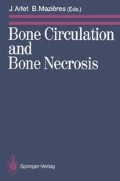Abstract
According to Salter’s prognostic classification, epiphyseal detachment fractures that cut the growth plate vertically (types III and IV) very often lead to complications involving epiphyseodesis. The mechanism governing the occurrence of this growth arrest has not yet been clearly defined. One proposed hypothesis for its origin is a disturbance in epiphyseal vascularization.
Access this chapter
Tax calculation will be finalised at checkout
Purchases are for personal use only
Preview
Unable to display preview. Download preview PDF.
References
Brashear HR (1963) Epiphyseal avascular necrosis and its relation to longitudinal bone growth. J Bone Joint Surg [Am] 45A:1423–1438
Bunger C, Hjermind J, Bulow F (1983) Hemodynamics of the juvenile knee in relation to increasing intra articular pressure. Acta Orthop Scand 54 (1):80–87
Morris MA, Kelly PJ (1980) Use of tracer microspheres to measure bone blood flow in conscious dogs. Calcif Tissue Res 32:69–76
Phemister DB (1933) Operative arrestment of longitudinal growth of bones in the treatment of deformities. J Bone Joint Surg [Br] 15:1
Salter B, Harris WR (1963) Injuries involving the epiphyseal plate. J Bone Joint Surg [Am] 45A:587
Schnitzer JE, McKinstry P, Light TR, Ogden JA (1980) Quantitation of regional Chondro osseous circulation in canine tibia and femur. Am J Physiol 242H (5): 365–437
Shapiro F, Holtrop ME, Glimcher MJ (1977) Organization and cellular biology of the chondreal ossification groove of Ranvier. J Bone Joint Surg [Am] 59A: 703
Teot L, Bosse JP, Gilbert A, Tremblay GR (1983) Pedicle graft epiphysis transplantation. Clin Orthop 180:206–218
Trias A, Teot L, Tetreault (1984) Epiphyseal blood flow in the normal piglet and its changes in experimental necrosis in the femoral head. In: Arlet J, Ficat RP, Hungerford DS (eds) Bone Circulation. Williams and Wilkins, Baltimore
Editor information
Editors and Affiliations
Rights and permissions
Copyright information
© 1990 Springer-Verlag Berlin Heidelberg
About this paper
Cite this paper
Teot, L., Baillat, X. (1990). Blood Flow in Experimental Epiphyseal Plate Fractures in the Dog. In: Arlet, J., Mazières, B. (eds) Bone Circulation and Bone Necrosis. Springer, Berlin, Heidelberg. https://doi.org/10.1007/978-3-642-73644-5_39
Download citation
DOI: https://doi.org/10.1007/978-3-642-73644-5_39
Publisher Name: Springer, Berlin, Heidelberg
Print ISBN: 978-3-642-73646-9
Online ISBN: 978-3-642-73644-5
eBook Packages: Springer Book Archive

